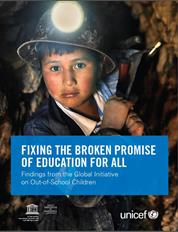Simply expanding educational systems has clearly failed to reach all children. As the international community works to establish new development goals, it will be imperative to focus on the children who were left behind.
 We believe that robust data on out-of-school children can help.
We believe that robust data on out-of-school children can help.
A new report from UNICEF and the UNESCO Institute for Statistics (UIS) demonstrates how the latest data and policy analysis can help us move forward. The report, Fixing the Broken Promise of Education for All: Findings from the Global Initiative on Out-of-School Children, draws on data from 26 country studies and seven regional studies. Funded by the Global Partnership for Education, it serves as a roadmap to improve the data, research and policies that are needed to reach the most marginalized children.
What data tell us
Data can tell us who the out-of-school children are, where they live, and why they are excluded. Data also enable us to develop and evaluate policies designed to reach excluded children. A new data exploration tool that accompanies the report presents a nuanced picture of out-of-school children around the world and pinpoints the critical factors that drive exclusion. It also shows the ways in which data can be used for effective policymaking, especially when resources are scarce.
The way forward
As the world embarks on a new development agenda, we must invest in better data so we can more effectively reach out-of-school children. Experience from the Global Initiative on Out-School-Children shows some important first steps.
Delve deeper into existing data sources
Administrative data collected by education ministries can be used to determine where and when students start school late or drop out. Household surveys are another rich source. And adding education questions to these surveys would throw brighter light on the most marginalized children. Indeed, information from these sources can unlock valuable insights for policymakers.
Invest in collecting data on vulnerable groups
If we do not target data collection, vulnerable groups will continue to be overlooked. For example, the initiative on out-of-school children has collected detailed data on children who were living in shelters or on the streets in conflict-affected provinces of the Democratic Republic of the Congo. The survey was a first step towards developing and implementing effective education policies to provide educational opportunities for these children.
Similarly, in Central and Eastern Europe and the Commonwealth of Independent States, a new system has been put in place to monitor children with disabilities – children who are often overlooked by education policies.
Use new technologies to identify and reach at-risk children
Improving links between different national data sources can improve the monitoring of children as they move through the education system. But to benefit truly from advances in information management systems, national and district-level authorities need greater support and training.
And finally, it is critical to increase financial and technical support to national statistical offices and education ministries. Better data and more innovative tools will help governments and donors spend their education budgets more wisely. But these data will also help us reach the world's most marginalized children.
The Global Initiative on Out-of-School Children – a UNICEF and the UNESCO Institute for Statistics (UIS) partnership – works in more than 50 countries to identify which children are out of school, assess the barriers of exclusion and develop innovative policies so they can go to school and learn. The Initiative is funded by the Global Partnership for Education and the World Bank.
By Jo Bourne and Albert Motivans

